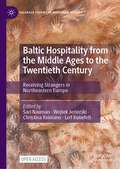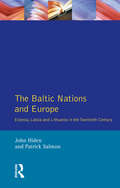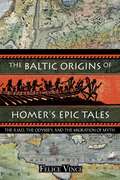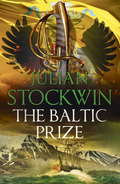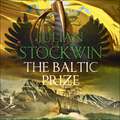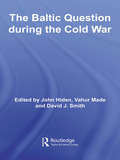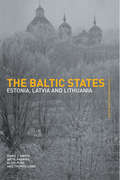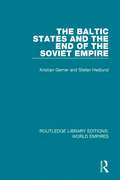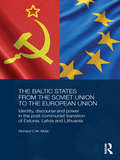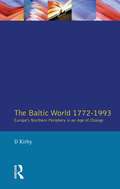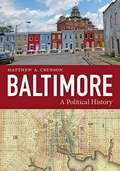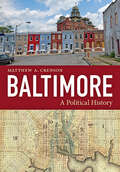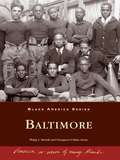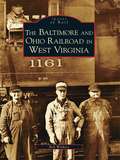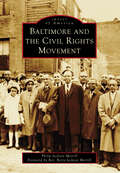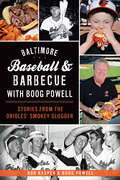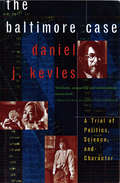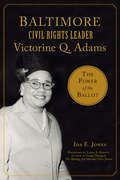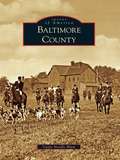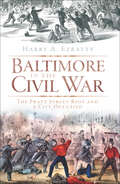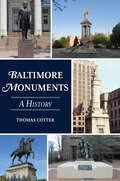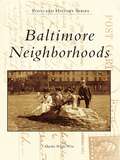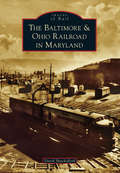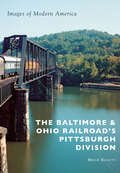- Table View
- List View
Baltic Hospitality from the Middle Ages to the Twentieth Century: Receiving Strangers in Northeastern Europe (Palgrave Studies in Migration History)
by Christina Reimann Wojtek Jezierski Sari Nauman Leif RunefeltReflecting debate around hospitality and the Baltic Sea region, this open access book taps into wider discussions about reception, securitization and xenophobic attitudes towards migrants and strangers. Focusing on coastal and urban areas, the collection presents an overview of the responses of host communities to guests and strangers in the countries surrounding the Baltic Sea, from the early eleventh century to the twentieth. The chapters investigate why and how diverse categories of strangers including migrants, war refugees, prisoners of war, merchants, missionaries and vagrants, were portrayed as threats to local populations or as objects of their charity, shedding light on the current predicament facing many European countries. Emphasizing the Baltic Sea region as a uniquely multi-layered space of intercultural encounter and conflict, this book demonstrates the significance of Northeastern Europe to migration history.
The Baltic Nations and Europe: Estonia, Latvia and Lithuania in the Twentieth Century
by John Hiden Patrick SalmonOf all the Soviet Union's subject nationalities, the three Baltic republics, Estonia, Latvia and Lithuania, were the most determined and best organised in seizing the opportunities created by glasnost and perestroika to win freedom from Moscow's grip.At the time of first publication, in 1991, the final section of the book was speculative. Now for this revised edition, the authors have provided a new final chapter which brings the story up to date -- and the three republics to political independence again.
The Baltic Origins of Homer's Epic Tales: The Iliad, the Odyssey, and the Migration of Myth
by Felice VinciCompelling evidence that the events of Homer's Iliad and Odyssey took place in the Baltic and not the Mediterranean• Reveals how a climate change forced the migration of a people and their myth to ancient Greece • Identifies the true geographic sites of Troy and Ithaca in the Baltic Sea and Calypso's Isle in the North Atlantic OceanFor years scholars have debated the incongruities in Homer's Iliad and Odyssey, given that his descriptions are at odds with the geography of the areas he purportedly describes. Inspired by Plutarch's remark that Calypso's Isle was only five days sailing from Britain, Felice Vinci convincingly argues that Homer's epic tales originated not in the Mediterranean, but in the northern Baltic Sea. Using meticulous geographical analysis, Vinci shows that many Homeric places, such as Troy and Ithaca, can still be identified in the geographic landscape of the Baltic. He explains how the dense, foggy weather described by Ulysses befits northern not Mediterranean climes, and how battles lasting through the night would easily have been possible in the long days of the Baltic summer. Vinci's meteorological analysis reveals how a decline of the "climatic optimum" caused the blond seafarers to migrate south to warmer climates, where they rebuilt their original world in the Mediterranean. Through many generations the memory of the heroic age and the feats performed by their ancestors in their lost homeland was preserved and handed down to the following ages, only later to be codified by Homer in the Iliad and the Odyssey.Felice Vinci offers a key to open many doors that allow us to consider the age-old question of the Indo-European diaspora and the origin of the Greek civilization from a new perspective.
The Baltic Prize: Thomas Kydd 19
by Julian Stockwin1808. Parted from his new bride, Captain Sir Thomas Kydd is called away to join the Northern Expedition to Sweden, now Britain's only ally in the Baltic. Following the sudden declaration of war by Russia and with the consequent threat of the czar's great fleet in St Petersburg, the expedition must defend Britain's dearly-won freedom in those waters. However Kydd finds his popular fame as a frigate captain is a poisoned chalice; in the face of jealousy and envy from his fellow captains, the distrust of the commander-in-chief and the betrayal of friendship by a former brother-in-arms now made his subordinate, can he redeem his reputation?In an entirely hostile sea Tyger ranges from the frozen north to the deadly confines of the Danish Sound - and plays a pivotal role in the situation ensuing after the czar's sudden attack on Finland. This climaxes in the first clash of fleets between Great Britain and Russia in history. To the victor will be the prize of the Baltic!******************PRAISE FOR JULIAN STOCKWIN'S THOMAS KYDD SERIES'Paints a vivid picture of life aboard the mighty ship-of-the-line' Daily Express'This heady adventure blends fact and fiction in rich, authoritative detail' Nautical Magazine on VICTORY'Fans of fast-paced adventure will get their fill with this book' Historical Naval Society on THE ADMIRAL'S DAUGHTER
The Baltic Prize: Thomas Kydd 19 (Thomas Kydd #19)
by Julian Stockwin1808. Parted from his new bride, Captain Sir Thomas Kydd is called away to join the Northern Expedition to Sweden, now Britain's only ally in the Baltic. Following the sudden declaration of war by Russia and with the consequent threat of the czar's great fleet in St Petersburg, the expedition must defend Britain's dearly-won freedom in those waters. However Kydd finds his popular fame as a frigate captain is a poisoned chalice; in the face of jealousy and envy from his fellow captains, the distrust of the commander-in-chief and the betrayal of friendship by a former brother-in-arms now made his subordinate, can he redeem his reputation?In an entirely hostile sea Tyger ranges from the frozen north to the deadly confines of the Danish Sound - and plays a pivotal role in the situation ensuing after the czar's sudden attack on Finland. This climaxes in the first clash of fleets between Great Britain and Russia in history. To the victor will be the prize of the Baltic!******************PRAISE FOR JULIAN STOCKWIN'S THOMAS KYDD SERIES'Paints a vivid picture of life aboard the mighty ship-of-the-line' Daily Express'This heady adventure blends fact and fiction in rich, authoritative detail' Nautical Magazine on VICTORY'Fans of fast-paced adventure will get their fill with this book' Historical Naval Society on THE ADMIRAL'S DAUGHTER
The Baltic Prize: Thomas Kydd 19 (Thomas Kydd #19)
by Julian StockwinThe nineteenth novel in Julian Stockwin's acclaimed Captain Kydd series.1808. Parted from his new bride, Captain Sir Thomas Kydd is called away to join the Northern Expedition to Sweden, now Britain's only ally in the Baltic. Following the sudden declaration of war by Russia and with the consequent threat of the czar's great fleet in St Petersburg, the expedition must defend Britain's dearly-won freedom in the those waters. However Kydd finds his popular fame as a frigate captain is a poisoned chalice; in the face of jealousy and envy from his fellow captains, the distrust of the commander-in-chief and the betrayal of friendship by a former brother-in-arms now made his subordinate, can he redeem his reputation?In an entirely hostile sea Tyger ranges from the frozen north to the deadly confines of the Danish Sound - and plays a pivotal role in the situation ensuing after the czar's sudden attack on Finland. This climaxes in the first clash of fleets between Great Britain and Russia in history. To the victor will be the prize of the Baltic!(P)2017 Hodder & Stoughton Limited
The Baltic Question during the Cold War (Cold War History)
by John Hiden Vahur Made David J. SmithThis edited volume presents a comprehensive analysis of the ‘Baltic question’, which arose within the context of the Cold War, and which has previously received little attention. This volume brings together a group of international specialists on the international history of northern Europe. It combines country-based chapters with more thematic approaches, highlighting above all the political dimension of the Baltic question, locating it firmly in the context of international politics. It explores the policy decision-making mechanisms which sustained the Western non-recognition of Soviet sovereignty over the Baltic States after 1940 and which eventually led to the legal restoration of the three countries’ statehood in 1991. The wider international ramifications of this doctrine of legal continuity are also examined, within the context both of the Cold War and of relations between post-soviet Russia and the enlarging ‘Euro-Atlantic area’. The book ends with an examination of how this Cold War legacy continues to shape relations between Russia and the West.
The Baltic States: Estonia, Latvia and Lithuania (Postcommunist States and Nations #3)
by Thomas Lane Artis Pabriks Aldis Purs David J. SmithSince the end of the Cold War there has been an increased interest in the Baltics. The Baltic States brings together three titles, Estonia, Latvia and Lithuania, to provide a comprehensive and analytical guide integrating history, political science, economic development and contemporary events into one account. Since gaining their independence, each country has developed at its own pace with its own agenda and facing its own obstacles. The authors examine the tensions accompanying a post-communist return to Europe after the long years of separation and how each country has responded to the demands of becoming a modern European state. Estonia was the first of the former Soviet republics to enter membership negotiations with the European Union in 1988 and is a potential candidate for the next round of EU expansion in 2004. Lithuania and Latvia have also expressed their desire for future membership of NATO and the EU.
The Baltic States and the End of the Soviet Empire (Routledge Library Editions: World Empires)
by Kristian Gerner Stefan HedlundFirst published in 1993. How is it possible for the three tiny Baltic republics to gain their freedom from the Soviet Union, without a single shot being fired or a single stone thrown at the oppressor? The topic of this book is the implosion of the Soviet empire. It tells the parallel stories of how the three Baltic republics of Estonia, Latvia and Lithuania struggled successfully to gain their freedom, and how the policies pursued by Mikhail Gorbachev served to mobilize and politicize Baltic demands. Particular emphasis is placed on unintended consequences that resulted from repeated interventions by Moscow. The authors develop a loose theoretic framework for the examination of this critical struggle. The study starts by developing the analytical tools and then proceeds to outline, as background, the most salient features of Gorbachev's reform programme and of the history of the Baltic States. The core of the analysis is then presented in three chapters, devoted to three consecutive stages in the game. The first shows how strategies on both sides were initially formulated in consensus. In the second it is shown how consensus transformed into pure conflict, and in the third all actors are seeking to escape general collapse. The main conclusion points at the absence of ‘politics’ in the Soviet System as a main cause of its self-destruction.
The Baltic States from the Soviet Union to the European Union: Identity, Discourse and Power in the Post-Communist Transition of Estonia, Latvia and Lithuania (BASEES/Routledge Series on Russian and East European Studies)
by Richard MoleThe Baltic States are unique in being the only member-states of the EU to have fought to regain their sovereignty from the Soviet Union, only then to cede it to Brussels in certain key areas. Similarly, no member-states have had to struggle as hard as Estonia, Latvia and Lithuania to preserve their identity after fifty years of Soviet nationality policy in the face of sub-state and supra-state challenges. The post-communist experience of the Baltic States thus allows us to examine debates about identity as a source of political power; the conditioning and constraining influence of identity discourses on social, political and economic change; and the orientation and outcome of their external relations. In particular, the book examines the impact of Russian and Soviet control of Estonia, Latvia and Lithuania; the Baltic independence movements of the late 1980s/early 1990s; the citizenship debates; relations with Russia vis-à-vis the withdrawal of the troops of the former Soviet Army; drawing of the shared boundary and the rights of Russian-speaking minorities as well as the efforts undertaken by the three Baltic States to rebuild themselves, modernise their economies, cope with the ensuing social changes and facilitate their accession to the EU and NATO.
The Baltic World 1772-1993: Europe's Northern Periphery in an Age of Change
by David KirbyThis eagerly-awaited sequel shares the characteristics of its distinguished predecessor -- wide geographical and chronological span; expert mingling of political, social and economic history; and Dr Kirby's ability to keep the separate national threads of his account from tangling as he weaves them into the broad regional picture that is his main concern. Here he tackles the contrasting experiences of Europe's northern periphery -- affluence and democracy in the north, stagnation and authoritarianism in the south -- from the French Revolution to the collapse of the USSR and beyond. This is a masterly study of a region that is far from peripheral politically to the post-Soviet world.
Baltimore: A Political History
by Matthew A. CrensonHow politics and race shaped Baltimore's distinctive disarray of cultures and subcultures. Charm City or Mobtown? People from Baltimore glory in its eccentric charm, small-town character, and North-cum-South culture. But for much of the nineteenth century, violence and disorder plagued the city. More recently, the 2015 death of Freddie Gray in police custody has prompted Baltimoreans--and the entire nation--to focus critically on the rich and tangled narrative of black–white relations in Baltimore, where slavery once existed alongside the largest community of free blacks in the United States. Matthew A. Crenson, a distinguished political scientist and Baltimore native, examines the role of politics and race throughout Baltimore's history. From its founding in 1729 up through the recent past, Crenson follows Baltimore's political evolution from an empty expanse of marsh and hills to a complicated city with distinct ways of doing business. Revealing how residents at large engage (and disengage) with one another across an expansive agenda of issues and conflicts, Crenson shows how politics helped form this complex city's personality. Crenson provocatively argues that Baltimore's many quirks are likely symptoms of urban underdevelopment. The city's longtime domination by the general assembly--and the corresponding weakness of its municipal authority--forced residents to adopt the private and extra-governmental institutions that shaped early Baltimore. On the one hand, Baltimore was resolutely parochial, split by curious political quarrels over issues as minor as loose pigs. On the other, it was keenly attuned to national politics: during the Revolution, for instance, Baltimoreans were known for their comparative radicalism. Crenson describes how, as Baltimore and the nation grew, whites competed with blacks, slave and free, for menial and low-skill work. He also explores how the urban elite thrived by avoiding, wherever possible, questions of slavery versus freedom--just as wealthier Baltimoreans, long after the Civil War and emancipation, preferred to sidestep racial controversy. Peering into the city's 300-odd neighborhoods, this fascinating account holds up a mirror to Baltimore, asking whites in particular to reexamine the past and accept due responsibility for future racial progress.
Baltimore: A Political History
by Matthew A. CrensonHow politics and race shaped Baltimore's distinctive disarray of cultures and subcultures.Charm City or Mobtown? People from Baltimore glory in its eccentric charm, small-town character, and North-cum-South culture. But for much of the nineteenth century, violence and disorder plagued the city. More recently, the 2015 death of Freddie Gray in police custody has prompted Baltimoreans—and the entire nation—to focus critically on the rich and tangled narrative of black–white relations in Baltimore, where slavery once existed alongside the largest community of free blacks in the United States.Matthew A. Crenson, a distinguished political scientist and Baltimore native, examines the role of politics and race throughout Baltimore's history. From its founding in 1729 up through the recent past, Crenson follows Baltimore's political evolution from an empty expanse of marsh and hills to a complicated city with distinct ways of doing business. Revealing how residents at large engage (and disengage) with one another across an expansive agenda of issues and conflicts, Crenson shows how politics helped form this complex city's personality.Crenson provocatively argues that Baltimore's many quirks are likely symptoms of urban underdevelopment. The city's longtime domination by the general assembly—and the corresponding weakness of its municipal authority—forced residents to adopt the private and extra-governmental institutions that shaped early Baltimore. On the one hand, Baltimore was resolutely parochial, split by curious political quarrels over issues as minor as loose pigs. On the other, it was keenly attuned to national politics: during the Revolution, for instance, Baltimoreans were known for their comparative radicalism. Crenson describes how, as Baltimore and the nation grew, whites competed with blacks, slave and free, for menial and low-skill work. He also explores how the urban elite thrived by avoiding, wherever possible, questions of slavery versus freedom—just as wealthier Baltimoreans, long after the Civil War and emancipation, preferred to sidestep racial controversy. Peering into the city's 300-odd neighborhoods, this fascinating account holds up a mirror to Baltimore, asking whites in particular to reexamine the past and accept due responsibility for future racial progress.
Baltimore (Black America Series)
by Uluaipou-O-Malo Aiono Philip J. MerrillThroughout the years, the city of Baltimore has played host to many well-known figures, including Louis Armstrong, Duke Ellington, and boxer Joe Louis; the city has been called home by Billie Holiday, Frederick Douglass, and Thurgood Marshall. But it is the local African-American community's members, working diligently to advance and empower themselves, who made history while they lived it.
Baltimore and Ohio Railroad in West Virginia, The
by Bob WithersIn 1827, a group of Baltimore capitalists feared their city would be left out of the lucrative East Coast-to-Midwest trade that other eastern cities were developing; thus, the Baltimore and Ohio Railroad was chartered. Political pressure kept the B&O out of Pennsylvania at first, and so track crewsheaded for what is now West Virginia, building mountainous routes with torturous grades to Wheeling and Parkersburg. Eventually the B&O financed and acquired a spiderweb of branch lines that covered much of the northern and central parts of the Mountain State. This book takes a close look at the line's locomotives, passenger and freight trains,structures, and, most importantly, its people who endeared their company to generations of travelers, shippers, and small Appalachian communities.
Baltimore and the Civil Rights Movement (Images of America)
by Philip J. MerrillIn all aspects of life, from politics and education to religion and business, the Black Baltimore community has been a leader for civil rights. From the 19th century until the 1970s, Baltimore has been at the forefront of various civil rights movements. Black Baltimoreans helped establish the Niagara Movement, the precursor to the National Association for the Advancement of Colored People (NAACP), and had one of the most active NAACP branches, counting among its members pastors, politicians, entrepreneurs, educators, athletes, musicians, and others. Meritorious services were rendered by Rev. Harvey Johnson; William Ashbie Hawkins; Lillie Carroll Jackson; Lillie's daughter Juanita Jackson Mitchell; Juanita's husband, Clarence Maurice Mitchell Jr.; Walter Thomas Dixon; Enolia McMillan; Lena King Lee; and countless others who created a proud legacy of activism in the Monumental City.
Baltimore Baseball & Barbecue with Boog Powell: Stories from the Orioles' Smokey Slugger (American Palate)
by Boog Powell Rob KasperSince he started smacking long balls for the Baltimore Orioles, John "Boog" Powell has enjoyed the gustatory delights of his adopted hometown. A four-time All-Star and a fixture in two World Series, Boog also knows how to make one heck of a pit beef sandwich. Backyard barbecues at Boog's Baltimore row house were once a post-game tradition for the team. After hanging up his spikes, the former MVP set up his now iconic barbecue operation at Camden Yards. Baltimore author Rob Kasper takes a behind-the-scenes look at the life of this smoky slugger from his Florida boyhood through his rise to major-league glory and beyond. Told in Boog's colorful style, this rollicking journey is spiced with recipes and topped off with interviews from former teammates like Brooks Robinson, Frank Robinson and Jim Palmer.
The Baltimore Case: A Trial of Politics, Science, and Character
by Daniel J. Kevles"You read with a rising sense of despair and outrage, and you finish it as if awakening from a nightmare only Kafka could have conceived."--Christopher Lehmann-Haupt, New York Times David Baltimore won the Nobel Prize in medicine in 1975. Known as a wunderkind in the field of immunology, he rose quickly through the ranks of the scientific community to become the president of the distinguished Rockefeller University. Less than a year and a half later, Baltimore resigned from his presidency, citing the personal toll of fighting a long battle over an allegedly fraudulent paper he had collaborated on in 1986 while at MIT. From the beginning, the Baltimore case provided a moveable feast for those eager to hold science more accountable to the public that subsidizes its research. Did Baltimore stonewall a legitimate government inquiry? Or was he the victim of witch hunters? The Baltimore Case tells the complete story of this complex affair, reminding us how important the issues of government oversight and scientific integrity have become in a culture in which increasingly complicated technology widens the divide between scientists and society.
Baltimore Civil Rights Leader Victorine Q. Adams: The Power of the Ballot (American Heritage)
by Ida E. JonesVictorine Quille Adams was a Baltimore native and the first African American woman elected to the city council. Born in 1912, she lived through stringent segregation, racial violence and economic turbulenceVictorine Quille Adams was a Baltimore native and the first African American woman elected to the city council. Born in 1912, she lived through stringent segregation, racial violence and economic turbulence.Educated at Morgan State and Coppin State Universities, she took to the classroom and enriched the lives of her students. In 1946, she founded the Colored Women's Democratic Campaign Committee to educate African American women about the vote and the power of the ballot box. In concert with fellow educators Mary McLeod Bethune, Kate Sheppard and Dr. Delores Hunt, she persisted in educating and empowering voters throughout her life. Author Ida E. Jones reveals the story of this civic leader and her crusade for equity for all people in Baltimore.
Baltimore County
by Gayle Neville BlumIn its beginnings, Baltimore County was covered with dense ancient forests of deciduous trees and so little undergrowth that it was said a man could gallop horses within them. Today horses gallop over bucolic pastures of renowned Thoroughbred farms amidst quaint historic towns seen dotting the rolling landscape. Named for the Lords Baltimore, Baltimore County was originally an expansive area extending well beyond today's boundaries. Founded in 1659, the county has evolved from tobacco farming to diverse industries ranging from steel manufacturing to picturesque vineyards. Both then and now, nearby Baltimore Harbor on the Chesapeake Bay provides lucrative opportunities for merchants to trade their crops and commodities. The county offers endless recreational pursuits on over 175 miles of shoreline. Baltimore County is proud to claim among its residents the noted neurosurgeon Dr. Benjamin Carson; baseball's all-time iron man, Cal Ripken; and famous author Tom Clancy.
Baltimore in the Civil War: The Pratt Street Riot and a City Occupied (Civil War Ser.)
by Harry A. EzrattyOn April 19, 1861, the first blood of the Civil War was spilled in the streets of Baltimore. En route to Camden Station, Union forces were confronted by angry Southern sympathizers, and at Pratt Street the crowd rushed the troops, who responded with lethal volleys. Four soldiers and twelve Baltimoreans were left dead. Marylanders unsuccessfully attempted to further cut ties with the North by sabotaging roads, bridges and telegraph lines. In response to the "Battle of Baltimore," Lincoln declared martial law and withheld habeas corpus in much of the state. Author Harry Ezratty skillfully narrates the events of that day and their impact on the rest of the war, when Baltimore became a city occupied.
Baltimore Monuments: A History (History & Guide)
by Thomas CotterTour the monuments of the Monumental City.From its beginning as a small town on the banks of the Patapsco River in 1729, Baltimore has played a significant role in the development of the United States. To commemorate those persons or events that have contributed to the city and the nation's history, Baltimore was the first American city to build public monuments. Persons honored by these monuments have included artists, entertainers, athletes, civic leaders, government officials, military veterans, public servants, religious leaders, social reformers, and war heroes. Local historian Thomas Cotter discusses the history of each monument, its origin, notable designers, funding methods, dedication ceremony, and a description of the monument itself.
Baltimore Neighborhoods (Postcard History Series)
by Marsha Wight WiseBaltimore's rich diversity is represented by its many neighborhoods--95 at last count. Some neighborhoods meander for several city blocks while others claim only a few. This volume of vintage postcards provides unique glimpses into the past of many of Baltimore's neighborhoods. Included are the elegant homes of Roland Park, Guildford, and Sherwood Gardens; the workingman's Highlandtown, South Baltimore, and Locust Point; the streetcar suburbs of Mount Washington, Overlea, Ten Hills, and Hunting Ridge; and the city park-anchored communities of Patterson Park, Federal Hill, and Gwynns Falls. Readers will find no two communities alike.
Baltimore & Ohio Railroad in Maryland, The (Images of Rail)
by David ShackelfordIncorporated in 1827, the Baltimore & Ohio Railroad (B&O) was one of America's first railroads, and Maryland was its heart and soul. The B&O's creation was a tangible symbol of the Industrial Revolution, representing commerce and progress to towns along its route. Its headquarters and operations, centered in Baltimore, provided years of economic growth for the port city. This book contains images of well-known stations in Maryland, including Ellicott City Station, Gaithersburg Station, Camden Station, and the Mount Clare Shops--a self-contained industrial city, now home to the B&O Railroad Museum. Some stations still exist and are home to small museums or restaurants; others no longer stand, but images of them will remind even the casual historian of a time when railroads were a part of everyday life in America. Take a step back in time and revisit the sites, stations, and trains of the B&O that were once part of everyday life in Maryland and remember the glory of a bygone era.
The Baltimore & Ohio Railroad's Pittsburgh Division (Images of Modern America)
by Bruce ElliottThe Pittsburgh Division had its earliest beginnings in 1837, but what would be known as the main line was not completed until 1871. At its height, the Pittsburgh Division consisted of five distinct main lines and 14 branch lines, and the division had trackage rights over the Western Maryland and Pittsburgh & Lake Erie Railroads. Images of Modern America: The Baltimore & Ohio Railroad's Pittsburgh Division looks at five of these lines: the B&O Main Line from Cumberland to Pittsburgh; the Pittsburgh and Western; the Somerset and Cambria; the Fairmont, Morgantown and Pittsburgh; and the Wheeling, Pittsburgh and Baltimore.
